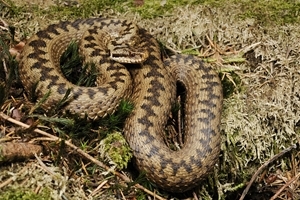Snakes
 There are three different species of snake in Britain, the smooth snake which is confined to the southern heathlands of England, the grass snake which can be found south of the Scottish borders and our only poisonous snake, the adder, which occurs throughout mainland Britain. There are no snakes at all in Ireland. The two that most people are likely to come across are the adder and grass snake, so I’m going to concentrate on these here.
There are three different species of snake in Britain, the smooth snake which is confined to the southern heathlands of England, the grass snake which can be found south of the Scottish borders and our only poisonous snake, the adder, which occurs throughout mainland Britain. There are no snakes at all in Ireland. The two that most people are likely to come across are the adder and grass snake, so I’m going to concentrate on these here.
The grass snake is easily the longest of the three, reaching up to five feet in length. It is a handsome beast with a striking yellow and black head and loves to be near water and so water meadows alongside rivers or streams are an ideal habitat for them. They spend from March to October cruising around preying on a wide range of food items, but frogs and toads are a great favourite. They are excellent swimmers and will also feed on newts and even small fish. If a nearby garden contains a compost heap, then the grass snake has everything it needs! These warm, moist piles of rotting vegetation are the perfect incubator for them to lay up to 40 matt white leathery eggs. The eggs take around ten weeks to hatch, and from day one the tiny grass snakes, no bigger than a worm, are independent.
All you normally see of a grass snake is the end of its tail slithering away into cover as it has felt the vibrations of your approach. If, however, you catch one it will rear up and hiss at you in spectacular fashion, looking as though it is about to strike, but of course this is all bluff. It may well also cover you in a yellow substance that smells of rotting flesh! If all of this is not enough for you to beat a hasty retreat, it will then coil up and roll over onto its back and mouth open, feign death. The belief is that by acting dead and because of the yellow liquid smelling rotten as well, a predator will leave it well alone. It can stay like this for some time until it is quite sure that you have gone, whereupon it turns over and slides off to safety – clever stuff!
The adder is a much smaller snake, usually only growing to around a couple of feet in length and is of course identified by the distinctive black zigzag pattern down its back, on a background colour of grey or brown. All our snakes hibernate over winter and one of the best times to see them is in the early morning spring sunshine as they bask in a sunny spot to warm up. Adders, in particular, sometimes seem reluctant to move from these favoured warming spots and so can be slowly and quietly approached offering good views. In April, the males can sometimes be seen “wrestling” with each other in a writhing entangled mess of snake that can speed past you, apparently completely oblivious to your presence, as they try and prove their superior strength to other competitors and claim a territory for themselves. As always when men have to prove how strong and virile they are – the girls will be watching and taking note!
Adders do not lay eggs, but instead give birth to six-inch little snakes in late summer, and once again these tiny creatures are immediately independent. They may be able to catch and feed on some small insect or the like, but those that are not born until September, may go into hibernation in October without ever having eaten!
Peter Thompson
Advisory

Download Peter Thompson's essential 26-page book, featuring beautiful photography and detailed profiles of Britain's wildlife
Download FREE >